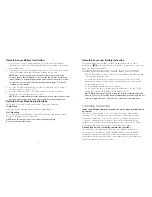
What is the recommended battery type?
We recommend using only alkaline batteries.
Where can I mount the remote sensor?
To get accurate readings and to prolong the life of your sensor, we
recommend
that you mount it out of direct sunlight and rain. Fog and mist will not
affect the
sensor, but large volumes of soaking rain may. To guard against this,
we
recommend that you mount it under the eve of your house, your
garage or any
other suitable place that will keep it out of direct sun and rain.
Modifications not authorized by the manufacturer may void users
authority to operate this device.
Outdoor Temperature Reading shows “- -”
This may indicate a low battery or out of transmission range.
SPECIFICATIONS
Range of temperature measurement:
Indoor temp : +32
º
F to +122
º
F (0
º
C to + 50
º
C)
Remote sensor: -4
º
F to +140
º
F (-20
º
C to +60
º
C)
Transmission: max. 100 ft. (30 m) open area, RF434 MHz
FCC DISCLAIMER
This device complies with part 15 of the FCC rules. Operation is
subject to the
following two conditions:
1. This device may not cause harmful interference, and
2. This device must accept any interference received, including
interference
that may cause undesired operation.
Freq. 434 MHz
FCC ID: TG3SS-5000TX (Transmitter)
Modifications not authorized by the manufacturer may void users authority to operate
this device.
Note: This equipment has been tested and found to comply with the limits for
a Class B digital device, pursuant to Part 15 of the FCC Rules. These limits
are designed to provide reasonable protection against harmful interference
in a residential installation. This equipment generates, uses and can radiate
radio frequency energy and, if not installed and used in accordance with
the instructions, may cause harmful interference to radio communications.
However, there is no guarantee that interference will not occur in a particular
installation. If this equipment does cause harmful interference to radio or
television reception, which can be determined by turning the equipment off and
on, the user is encouraged to try to correct the interference by one or more of
the following measures:
• Reorient or relocate the receiving antenna.
• Increase the separation between the equipment and receiver.
• Connect the equipment into an outlet on a circuit different from that to
which the receiver is connected.
• Consult the dealer or an experienced radio/TV technician for help
Note: The manufacturer is not responsible for any radio or TV interference caused by
unauthorized modifications to this equipment. Such modifications could void the
users authority to operate the equipment.
12
13
































